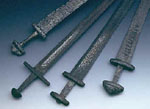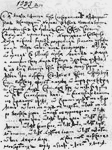 in Russian in Russian |
Suomeksi  |
history
| Written documents about the ancient Korela |
| About the origin of Karelian place-names |
 Iron weapons of Karelians |
| Chronology of Russian rulers |
| Swedish Kings and regents |
 Barter trade in Karelia |
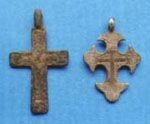 Probably in the 12th century orthodox Christianity starts penetrating the Ladoga area. evidence to that are Christian ornaments and Karelian toponyms. The frequent name "Riekkala" is derived from the karelian word "kreikala", that is, a place where a Greek lived.
Probably in the 12th century orthodox Christianity starts penetrating the Ladoga area. evidence to that are Christian ornaments and Karelian toponyms. The frequent name "Riekkala" is derived from the karelian word "kreikala", that is, a place where a Greek lived.  The "Our Father" prayer in Karelian with a translation to German |
| Map of Russia in 11-13th century |
 The Vyborg castle |
 The fortress of Korela |
 The ruins of the Kuusisto castle |
| A map of Russia in the 13-17th centuries. |
| Heliula in 1500 |
 A Russian map of Ladoga from the 17th century |
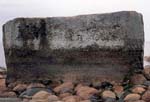 A border mark from 1617 - the Varashev Stone |
| A document from 1590 A document from 1618 A document from 1631 |
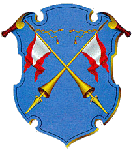 |
| Sortavala area on maps |
| A report in the first Russian newspaper "Vedomosti" about a defeat of Swedish troops by the Russian army near Serdobol |
| War action in the Sortavala area in 1789 |
| A story about the Kurikka-Hiekka battle near Sortavala |
 Education in parochial schools was given on a very good and modern level, in many respects due to hard work by the director of the Sortavala seminary, priest Sergiy Okulov. Rich spiritual life was concentrated in Valaam and Konevets monasteries and also in the women's monastery in Lintula, founded in 1895. In the late 19th century under abbot Damaskin's supervision a lot of construction work was carried out in the Valaamo monastery. In 1885 in Sortavala an Orthodox brotherhood of Saint Sergiy and Saint Herman was founded; since 1897 it published a newspaper called "Aamun koitto" ("The dawn").
Education in parochial schools was given on a very good and modern level, in many respects due to hard work by the director of the Sortavala seminary, priest Sergiy Okulov. Rich spiritual life was concentrated in Valaam and Konevets monasteries and also in the women's monastery in Lintula, founded in 1895. In the late 19th century under abbot Damaskin's supervision a lot of construction work was carried out in the Valaamo monastery. In 1885 in Sortavala an Orthodox brotherhood of Saint Sergiy and Saint Herman was founded; since 1897 it published a newspaper called "Aamun koitto" ("The dawn").
 Vyborg |
 Map of Heliulia from 1939 |
| A story of a Karelian wartime evacuee |
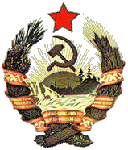 |
| Coat of arms of Karelian-Finnish SSR, 1940 type. |
In the creation of this page materials of the Lahdenpohja area history pages were used.
